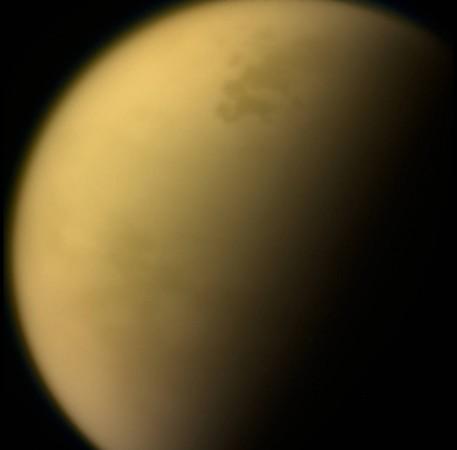
NASA astronomers, who were with NASA Cassini mission, have found toxic hybrid ice cloud over the south pole of Titan, the largest moon of the ringed planet Saturn. They have come to a conclusion that the ice cloud is made of organic molecule hydrogen cyanide and the large ring-shaped chemical benzene.
Here are the top things you need to know:
1. This hybrid ice cloud, which is referred to as the high-altitude south polar cloud by the researchers, was detected by the NASA astronomers who were with NASA Cassini mission, which ended after its Grand Finale on 15 September 2017.
2. The astronomers detected a wispy of toxic hybrid cloud portraying complex chemistry prevailing in Titan's atmosphere. This cloud formation was found prevailing in the stratosphere of the moon, covering a large area of 75 to 85 degrees south latitude on the south pole of the moon.
3. This finding was made using Composite Infrared Spectrometer (CIRS) on the Cassini spacecraft. This cloud formation is present at a height of 160 to 210 km (100 to 130 miles), way above the methane rain clouds present in Titan's troposphere, which is the lowest region of its atmosphere.
4. With the help of laboratory experiments, the chemical mixture matching the cloud's spectral signature was found. The CIRS instrument helped in scaling the chemical fingerprint of the cloud and found that it was made of organic molecule hydrogen cyanide and the large ring-shaped chemical benzene. The ice hybrid was formed by these chemicals that condensed to become ice particles.
"This cloud represents a new chemical formula of ice in Titan's atmosphere," said Carrie Anderson of NASA's Goddard Space Flight Center in Greenbelt, Maryland, a CIRS co-investigator.
"What's interesting is that this noxious ice is made of two molecules that condensed together out of a rich mixture of gases at the south pole," Anderson added.
5. The data previously accumulated by CIRS helped in detecting hydrogen cyanide ice present in the exotic clouds over the south pole of the large moon Titan. It also helped in identifying the presence of other toxic chemicals present in the stratosphere of the moon.
6. In Titan's stratosphere, a current of warm gases is sent by a global circulation pattern from the hemisphere where it's summer to the winter pole. The direction of the seasons change due to this circulation, this leads to creation of clouds at which ever pole experiences winter season.
This phenomenon was spotted on Titan's north pole by Cassini spacecraft soon after its arrival on Saturn. Similar phenomenon was detected by Cassini again at the south pole of the moon when Cassini almost completed its 13 years in the Saturn system.
7. The CIRS used by the researchers helped in sorting through the complex set of infrared fingerprints from many molecules in Titan's atmosphere. CIRS separates infrared light into its component colours, like raindrops creating a rainbow, and measures the strengths of the signal at the different wavelengths.
"CIRS acts as a remote-sensing thermometer and as a chemical probe, picking out the heat radiation emitted by individual gases in an atmosphere," said F. Michael Flasar, the CIRS principal investigator at Goddard. "And the instrument does it all remotely, while passing by a planet or moon."
8. At first, they let one gas condense before the other. But the best result was achieved by introducing both hydrogen cyanide and benzene into the chamber and allowing them to condense at the same time. By itself, benzene doesn't have a distinctive far-infrared fingerprint. When it was allowed to co-condense with hydrogen cyanide, however, the far-infrared fingerprint of the co-condensed ice was a close match for the CIRS observations, a NASA statement revealed.
Additional studies will be needed to determine the structure of the co-condensed ice particles. The researchers expect them to be lumpy and disorderly, rather than well-defined crystals.
9. The researchers previously found a similar example of co-condensed ice in CIRS data from 2005. Those observations were made near the north pole, about two years after the winter solstice in Titan's northern hemisphere. That cloud formed at a much lower altitude which was below 150 km (93 miles) and had a different chemical composition -- hydrogen cyanide and cyanoacetylene, which is one of the more complex organic molecules found in Titan's atmosphere.
"One of the advantages of Cassini was that we were able to flyby Titan again and again over the course of the thirteen-year mission to see changes over time," said Anderson. "This is a big part of the value of a long-term mission."

















